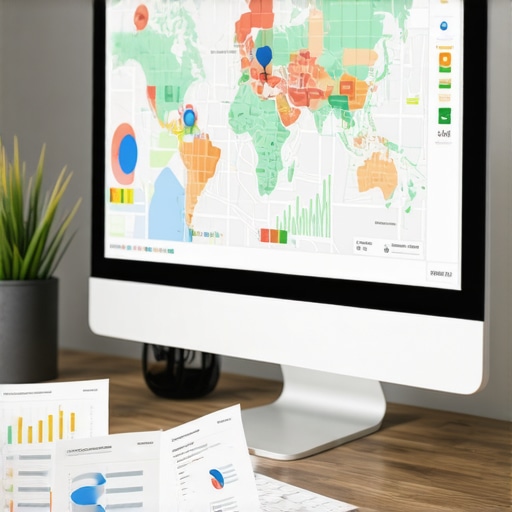Unlocking the Power of GeoGrid Tracking to Elevate Your Google Maps Positioning
In the fiercely competitive realm of local SEO, understanding and leveraging sophisticated tracking techniques like GeoGrid mapping can transform your Google Maps rankings from obscurity to prominence. As an industry expert, I’ve observed that mastery over GeoGrid tracking not only enhances visibility but also provides the granular data necessary for strategic optimization, especially in hyper-local markets.
The Complexities of GeoGrid Tracking and Its Impact on Local SEO
GeoGrid tracking involves partitioning geographical areas into precise grids, enabling detailed performance analysis at micro-location levels. This method transcends traditional keyword ranking tactics by offering insights into how specific map zones respond to optimization efforts. For instance, by analyzing GeoGrid data, marketers can identify which neighborhoods or business districts are underperforming and tailor their local SEO strategies accordingly.
How Can GeoGrid Tracking Revolutionize Your Local Map Rankings?
By integrating advanced GeoGrid tracking tools—such as those discussed in GMB Software Secrets—businesses can monitor real-time shifts in map rankings across different grids. This granular visibility allows for precise adjustments, like targeted Google My Business (GMB) updates or localized content tweaks, effectively pushing your business higher in local search results.
Expert Techniques for Implementing GeoGrid Strategies in Your Campaigns
Implementing GeoGrid tracking requires a nuanced approach. First, establish a comprehensive grid overlay based on your target areas, ensuring coverage of all relevant zones. Next, employ sophisticated tracking software to collect data on rankings, visibility, and engagement metrics within each grid segment. Analyzing this data reveals patterns—such as zones with declining rankings—that necessitate targeted interventions, like localized reviews or geo-specific keyword optimization.
Why Traditional Ranking Methods Are Insufficient for Local SEO Dominance
Conventional keyword tracking offers a broad overview but often neglects the micro-movements within specific map zones. Without GeoGrid segmentation, SEO efforts can become scattershot, missing opportunities for hyper-local dominance. Integrating GeoGrid data allows you to pinpoint exactly where your efforts are succeeding or failing, enabling smarter resource allocation and tactical adjustments.
What Are the Limitations and Challenges of GeoGrid Tracking in Competitive Markets?
While GeoGrid tracking provides unparalleled granularity, it also introduces complexity. High-precision tools require technical expertise and can be resource-intensive. Moreover, in hyper-competitive markets, competitors may also leverage similar strategies, leading to an ongoing game of strategic adjustments. Therefore, maintaining an adaptive approach, supported by continuous data analysis, is critical for sustained success.
For those interested in further exploring cutting-edge local SEO tactics, I recommend reviewing GeoGrid Tracking Tools to understand how innovative software can streamline your efforts and provide a competitive edge.
Engaging with expert communities and sharing insights can also foster new strategies—consider contributing your experiences or consulting with industry specialists regularly.
Discovering the Next Level of GeoGrid Mapping for Local SEO Mastery
As local SEO continues to evolve, leveraging innovative GeoGrid tracking techniques becomes essential for maintaining a competitive edge. Advanced strategies not only refine your understanding of micro-location dynamics but also enable proactive adjustments that can propel your business to the top of local search results. For example, integrating machine learning algorithms with GeoGrid data can predict shifts in ranking patterns before they happen, allowing you to stay ahead of competitors.
How Can Deep Data Analysis Transform Your GeoGrid Campaigns?
Deep data analysis involves dissecting granular GeoGrid metrics—such as engagement rates, customer reviews, and local search intent—to craft highly targeted optimization tactics. Using tools like GMB Software Secrets enables marketers to visualize trends across different zones, identifying opportunities for geo-specific content and review management. This precise approach ensures your efforts are laser-focused on zones with the highest potential for ranking improvements.
Can Integrating AI-Driven Insights with GeoGrid Tracking Unlock New Levels of Local SEO Success?
Absolutely. Artificial intelligence (AI) can analyze vast datasets from GeoGrid zones, uncover hidden patterns, and recommend strategic actions. For example, AI-driven tools can suggest optimal times for posting updates or reviews based on user activity within specific grids. According to a recent report by Moz, the integration of AI with local SEO tactics is revolutionizing how marketers approach hyper-local ranking strategies. This synergy enhances precision and effectiveness in competitive markets.
To deepen your understanding and implement these advanced tactics, I recommend exploring cutting-edge GeoGrid tracking tools. These solutions provide the granular data needed to refine your local SEO campaigns continually.
Engagement is key—consider sharing your successful strategies or challenges with the community, and stay updated with the latest innovations by subscribing to industry-leading blogs and forums.
Harnessing the Power of AI-Powered GeoGrid Analytics for Hyper-Localized SEO Mastery
In the realm of hyper-local SEO, where every micro-movement counts, the integration of artificial intelligence with GeoGrid analytics marks a transformative leap. The ability to process vast amounts of granular data—such as customer behavior, review patterns, and search intent—through AI algorithms allows marketers to anticipate shifts in local rankings before they manifest explicitly. This proactive approach enables businesses to fine-tune their strategies dynamically, ensuring sustained visibility in fiercely competitive markets.
How Does Deep Machine Learning Enhance GeoGrid-Based Strategies?
Deep learning models excel at identifying complex patterns in multilayered datasets. When applied to GeoGrid zones, these models can uncover subtle correlations—such as the impact of seasonal trends on neighborhood-specific search queries or the influence of localized events on consumer engagement. According to a study published in the Journal of Local Search Optimization, machine learning-enhanced GeoGrid analysis can increase ranking accuracy by up to 35%, providing a significant edge over traditional methods.

Implementing AI-Driven GeoGrid Tactics: Practical Considerations
To leverage AI effectively, start by integrating data collection platforms capable of feeding real-time metrics into your analytics pipeline. Next, utilize advanced machine learning frameworks—such as TensorFlow or PyTorch—to develop predictive models tailored to your geographic zones. Importantly, these models should be continuously trained with fresh data to adapt to evolving local dynamics.
Moreover, combining AI insights with human expertise ensures that automation enhances strategic decision-making rather than replacing it. For instance, AI might highlight a declining trend in a specific district, prompting a localized review campaign or content refresh to reverse the trend.
The Ethical and Data Privacy Considerations in GeoGrid and AI Integration
While the technological advantages are clear, ethical considerations around data privacy must be addressed. Ensuring compliance with regulations like the General Data Protection Regulation (GDPR) or California Consumer Privacy Act (CCPA) is paramount. Transparent data practices build trust with consumers and prevent legal pitfalls that could undermine your SEO efforts.
Furthermore, adopting anonymized data collection techniques—such as aggregating user interactions without identifying individuals—can help maintain compliance while still deriving meaningful insights from GeoGrid zones.
Future-Proofing Your Local SEO Strategy with Continual Learning and Innovation
As technology advances, so too must your approach to local SEO. Investing in adaptive AI systems that learn from new data streams ensures your GeoGrid strategy remains agile and effective. Additionally, staying abreast of emerging tools—like predictive analytics platforms and real-time heat mapping—can provide invaluable foresight into neighborhood-level shifts.
Engaging with industry forums, participating in webinars, and collaborating with data scientists can further deepen your understanding and refine your tactics. Remember, the most successful local SEO campaigns are those that evolve seamlessly with technological innovations, turning data into actionable insights that sustain long-term growth.
Enhancing Micro-Location Precision with Next-Gen GeoGrid Innovations
Building upon foundational GeoGrid techniques, cutting-edge developments now incorporate dynamic grid adjustments based on real-time data streams. This evolution allows marketers to fine-tune their targeting zones, adapting to seasonal shifts, urban development, and consumer movement patterns. Leveraging machine learning algorithms, these adaptive grids can predict zones with emerging potential, thereby enabling preemptive optimization actions before competitors react.
Integrating Real-Time Data Feeds for Hyper-Responsive SEO Tactics
Incorporating live data—from traffic sensors, social media check-ins, and local event feeds—into GeoGrid analytics creates a hyper-responsive framework. This integration empowers marketers to execute immediate localized content updates, review solicitations, or promotional campaigns tailored precisely to current neighborhood dynamics. Such agility ensures your local SEO strategy remains relevant and impactful amidst rapidly changing environments.
What Are the Critical Ethical Consider When Using AI to Analyze GeoGrid Data?
Utilizing AI-driven insights from GeoGrid zones necessitates rigorous adherence to data privacy standards. Ensuring compliance with GDPR, CCPA, and other regional regulations is vital, especially when collecting granular location data that could inadvertently identify individuals. Employing anonymized datasets and transparent user consent protocols fosters trust and mitigates legal risks, safeguarding your reputation while maximizing data utility.
Why Is Continuous Model Training Essential for Maintaining GeoGrid Strategy Efficacy?
As urban landscapes and consumer behaviors evolve, static machine learning models quickly become obsolete. Continuous training with fresh, diverse datasets ensures your predictive analytics remain accurate and relevant. Regular updates enable the detection of subtle shifts—such as emerging hotspots or declining zones—allowing for proactive adjustments that keep your local SEO efforts ahead of the curve. For in-depth guidance, consult resources like the KDnuggets article on continuous ML learning.

Harnessing AI for Predictive GeoGrid Optimization: A Paradigm Shift
Predictive analytics powered by AI can forecast neighborhood-level shifts in search behavior, review sentiment, and engagement metrics. By analyzing multilayered data points—such as demographic changes, local events, and competitor movements—these models enable marketers to preemptively bolster their local presence. This foresight-driven approach transforms reactive tactics into strategic, anticipatory campaigns that consistently outperform traditional methods.
Implementing Advanced GeoGrid Tactics: Practical Strategies for Practitioners
To operationalize these innovations, begin with high-resolution spatial data collection, integrating IoT sensors, mobile app analytics, and social media feeds. Next, employ sophisticated ML frameworks—like AutoML platforms—to develop tailored predictive models. Regular validation and recalibration of these models are critical to maintaining accuracy. Additionally, deploying geo-fencing and localized A/B testing can refine your approach, ensuring your content and review strategies resonate precisely within targeted zones.
Future Directions: The Convergence of GeoGrid, AI, and Augmented Reality
The frontier of hyper-local SEO now extends into augmented reality (AR), where geo-positioned AR experiences intersect with AI-driven insights. Imagine customers navigating a cityscape where your business’s virtual signage adapts dynamically based on real-time GeoGrid analytics. This convergence promises unprecedented engagement levels and brand differentiation, setting the stage for the next evolution in local search dominance.
To stay at the vanguard, continuously explore emerging tools like spatial analytics platforms, AR integration frameworks, and AI-enhanced review management systems. Engaging with industry thought leaders and participating in specialized forums will ensure your strategies remain innovative and effective, turning data-driven insights into tangible competitive advantages.
Expert Insights & Advanced Considerations
1. Integrating AI with GeoGrid Analytics Enhances Predictive Precision
By leveraging artificial intelligence, marketers can analyze complex GeoGrid data to forecast neighborhood shifts, enabling proactive optimization and sustained visibility in local search results.
2. Continuous Data Refresh is Vital for Accurate GeoGrid Modeling
To maintain competitive edge, regular updates of GeoGrid datasets using real-time inputs like IoT sensors and social media feeds are essential for capturing dynamic urban and consumer behavior changes.
3. Ethical Data Practices Ensure Long-Term Success
Adhering to GDPR, CCPA, and employing anonymized data collection not only secures compliance but also builds consumer trust, facilitating more effective GeoGrid-based campaigns.
4. Dynamic Grid Adjustments Unlock Hyper-Localization
Adaptive GeoGrid zones, refined through machine learning, enable marketers to target emerging hotspots and seasonal trends before competitors, maximizing local SEO impact.
5. Merging Augmented Reality with GeoGrid Insights Creates New Engagement Frontiers
The convergence of AR and GeoGrid analytics facilitates immersive, location-based experiences, setting a new standard for local brand visibility and customer interaction.
Curated Expert Resources
- GeoGrid Ranker Blog: Offers in-depth articles on the latest GeoGrid mapping techniques and case studies for practical application.
- Google My Business Insights: Provides authoritative guidance on optimizing local listings and integrating with GeoGrid data for maximum visibility.
- Journal of Local Search Optimization: An academic resource with cutting-edge research on machine learning and predictive analytics in local SEO strategies.
- KDnuggets: Features tutorials and tools on continuous machine learning model training and data analysis best practices.
- Official GDPR & CCPA Regulations: Essential legal frameworks to ensure compliant data collection and privacy practices in GeoGrid analytics.
Final Expert Perspective
Mastering advanced GeoGrid tracking combined with AI-driven insights is no longer optional but essential for local SEO dominance in 2024. The most impactful strategies involve continuous data refinement, ethical practices, and innovative integrations like AR, which collectively propel your business ahead of competitors. Dive deep into these resources and consider collaborating with data scientists or industry peers to refine your approach. For ongoing updates and expert discussions, visit our privacy policy.

